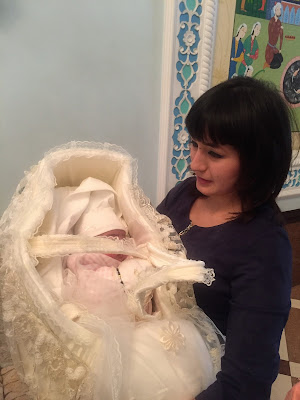After all the intense sightseeing we were doing in Samarkand, a good meal was in order. It's possible to get an American meal even in Uzbekistan. Crazy.
But why would we go there when we could go to a restaurant with this lovely statue of a girl in shorts and a tank top greeting us? (I wonder what Muslims, who comprise about 93% of the population of the country, think of her choice in clothes?)
The inside was quite a bit more traditional than the statue led us to believe:
I love the way the bread in this part of the world looks--so much more complex in design. Note the pinhole pattern in the center. However, I wouldn't rank it among the best breads in the world. When it was hot, it was good, but when it was cool, it tended to be dry and a little flavorless.
The dining room was modeled after the exquisite ancient architecture of Samarkand--lots of beautiful colors and patterns, lots of gilding:
 |
| That's Jim Tyndall at the head of the table. He and his wife Carol, who is on the left, own Fun-for- Less Tours. It was fun to have them along on the company's inaugural trip through the Stans. |
On our way out of the restaurant after we finished lunch, we saw three moms sitting on the sofas with their babies, each cradled in a lacy carrier
They were delighted that we wanted to take their picture!
Our next stop was Silk Carpets Uzbekistan, a very posh rug factory. Rugs are one of Uzbekistan's major exports and part of the Silk Road heritage. We had an English-speaking local guide describe the rug-making process:
We saw how the silk threads were spun into silk yarn:
Aren't the guide's slippers CUTE?
Oops, back on course. Here is a skein of silk . . .
. . . the dye vat:
. . . and the work room:
Some of the more intricate rugs required more than one weaver:
Watch these flying fingers:
Some rugs seem impossibly complex, such as the one below. Look at all these colors! That's the pattern above the horizontal bar and the weaving underneath it:
A rug like this one takes six months to a year to make. Hours are spent on a square centimeter.
For an excellent (and short) video of the rug-making process, see the factory's own website.
Supposedly the first paper ever created was made out of mulberry bark right here in Samarkand. A few years ago some brothers revived this ancient art and started producing mulberry paper at this factory using the ancient processes:
The "factory" was in a beautiful area next to a quiet stream shaded by lacy tree canopies:
We saw how the mulberry bark is shredded:
It is then boiled in a pot to create pulp:
I think these are giant mashers, used to further pulverize the pulp . . .
. . . until it looks like this:
The pulp is stirred . . .
. . . a wooden form is submerged in the pulp . . .
. . . and when it is lifted, voila!
Paper!
This mulberry bark paper is available in its natural state . . .
. . . or sanded to create a silky finish:


















































You were generous on the taste of the bread. I would classify it as pretty bad.
ReplyDeleteAnother fascinating post, but more down-to-earth. That bronze girl statue reminded me of the early 1970s in Peru: tank tops and hip-hugger pants (although hers seemed tucked into her boots or whatever). Maybe they think they are paying homage to our culture?
ReplyDelete